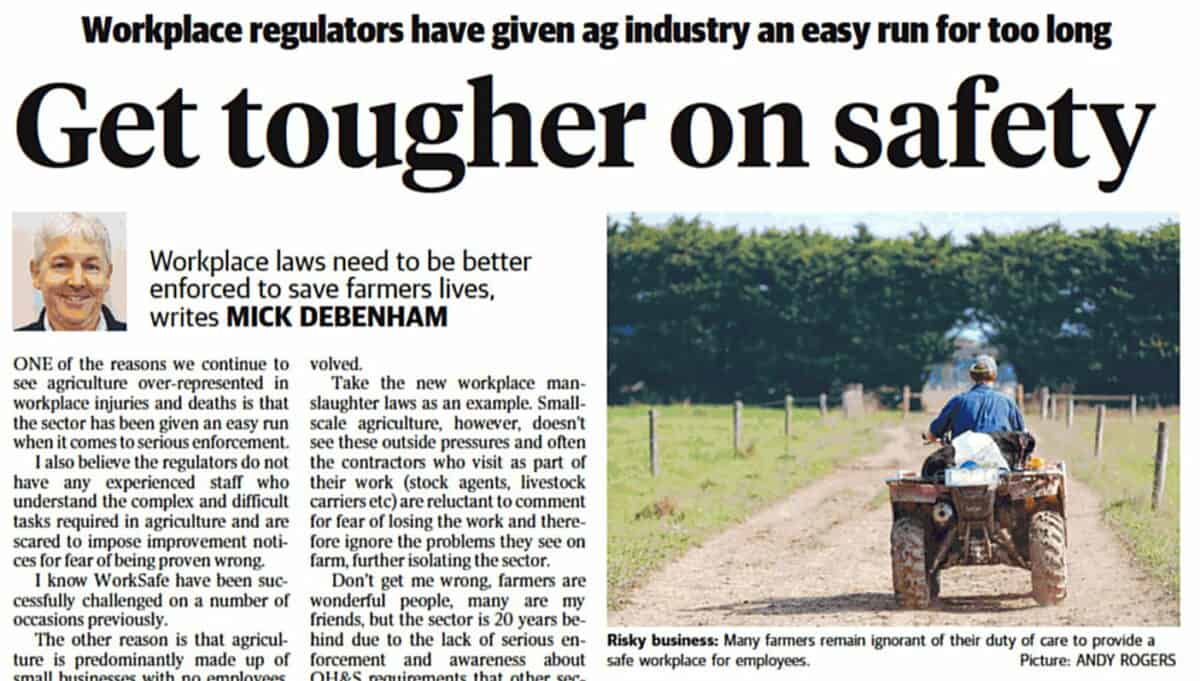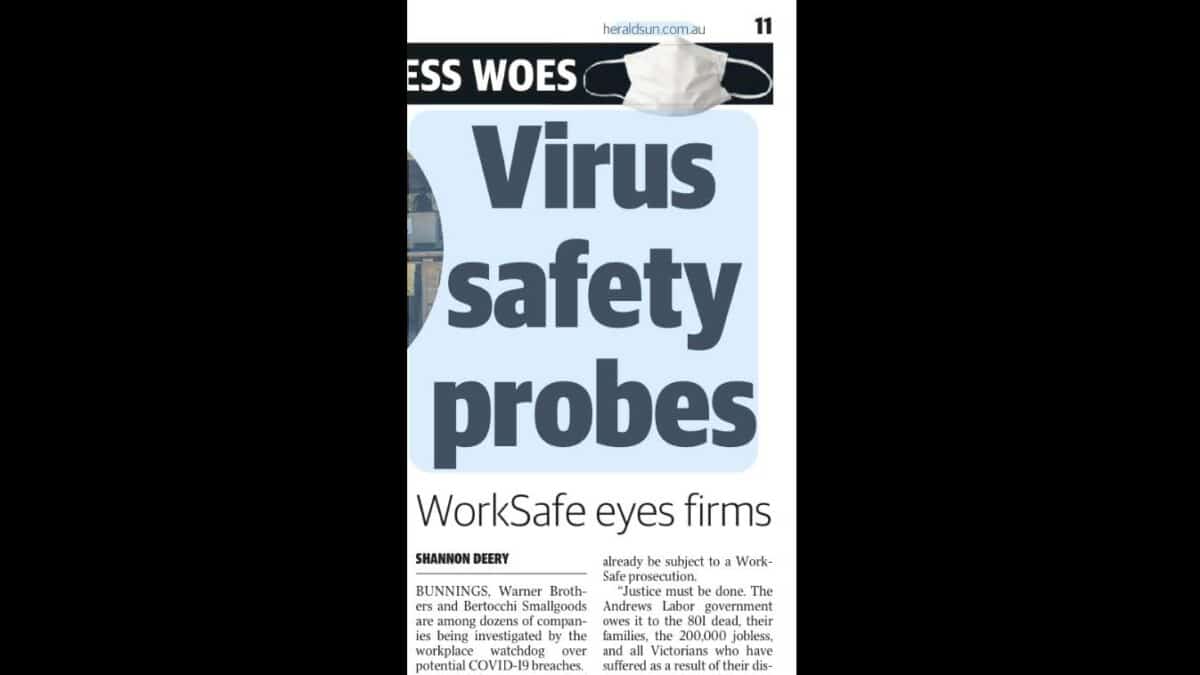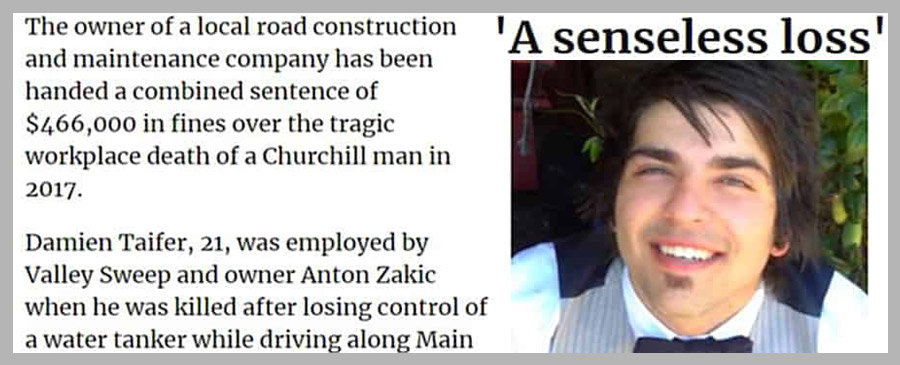One of the most difficult industries in which to achieve occupational health and safety (OHS) improvements is farming, especially in areas where farming continues to be done by small family units. The safety culture of farming is unique as the workplace is embedded in community and rural culture. Some people believe that OHS regulators have given the agricultural industry an easy run for too long, as stated by Mick Debenham in a recent opinion piece in The Weekly Times (paywalled), but farmers should perhaps ask themselves why people continue to die on their farms and what they can do to change this.
Category: WorkSafe
WorkSafe Victoria’s COVID19 OHS investigations
WorkSafe Victoria and its CEO Colin Radford have been pilloried by a couple of political and economic commentators recently, especially over the handling of the Hotel Quarantine Program. Radford and WorkSafe have wisely not reacted to the loudest voices and have continued their work investigating COVID19-related breaches of the occupational health and safety legislation.
One of the accusations of the commentators is that the OHS regulator has been slow to act. The Herald-Sun newspaper published an article on January 7, 2021 based on the list of companies being investigated but mentioned only a handful. The full list is included below.
Newspapers must make editorial decisions in relation to newspaper space so the omission of the full list is understandable. However, the online version, for which space is not an issue, still omitted the list or at least a hyperlink to the list. The online and printed articles are almost the same except that the online version omits the name of Australia’s largest hardware stores, Bunnings, from the first paragraph; an editorial decision (or error) that is hard to understand.
“exponential increase in mental injuries in the workplace” and other statements in a Victorian Parliament committee
Three years ago, WorkSafe Victoria indicated that it would consider prosecuting farmers for breaches of occupational health and safety (OHS) laws. That possibility seems to have disappeared based on the latest Minister for Workplace Safety’s appearance at the Public Accounts and Estimates Committee (PAEC).
Ingrid Stitt‘s appearance centred on questions related to the 2020-21 Budget Estimates and touched on Industrial Manslaughter, gig workers, mental health, and construction and farm safety.
Alan Jones vs Dan Andrews

The calls continue for the Victorian Premier, Dan Andrews, to be charged with Industrial Manslaughter over COVID19-related deaths that resulted from a poorly-managed hotel quarantine program. This time the topic was picked up be one of Australia’s conservative big guns, Alan Jones.
Jones hyperbolic rhetoric was on full display in his interview with Ken Phillips, who started the Andrews Industrial Manslaughter campaign.
Concussed sportspeople are workers too
David Michaels devoted a whole chapter to sport-related concussions and brain damage in his 2020 book “The Triumph of Doubt“. He wrote about how the National Football League obfuscated over the appearance of concussions and chronic traumatic encephalopathy, and how the the NFL downplayed the injury’s significance by referring to repeated head trauma as Mild Trauma Brain Injury.
The Australian experience is different and this was examined recently in an excellent edition of the ABC radio program, The Ticket. Significantly several interviewees mentioned the injuries in relation to occupational health and safety (OHS) and workers compensation.
More workplace bullshit, but in a good way
Bullshit is starting to gain some serious analysis with four researchers recently publishing “Confronting indifference toward truth: Dealing with workplace bullshit” in Business Horizons. One attraction of this research paper is its focus on workplace business communications and conversations, but it is almost impossible to read it without thinking of the recently ousted United States President and how lies and “fake news” have dominated international political discourse.
Another attraction is that it is not just an analysis but one that also suggests pathways to detect and reduce the bullshit. What I was unprepared for was to start to feel sympathy for the bullshitter.
Truck driver death is relevant to all
Well before the push for Industrial Manslaughter laws was the occupational health and safety (OHS) offence of “reckless conduct”. A media report from the LaTrobe Valley Express recently showed how one employer’s neglect of basic safety practices and processes resulted in the death on 21-year-old Damien Taifer.





